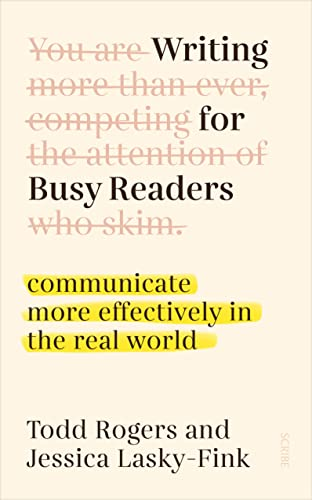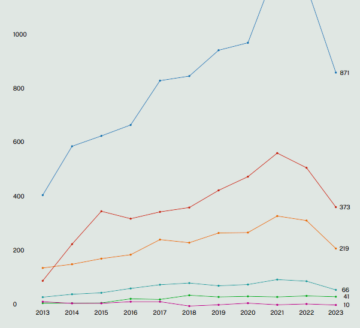This week, I stumbled upon an intriguing article from The Economist that holds valuable insights for entrepreneurs and marketing experts engaged in brand building. In an age where our digital lives are flooded with a constant stream of information, the ability to craft messages that cut through the noise has become a superpower.
“If everyone is a busy reader, everyone is a busy writer, too.”
Indeed, we live in a world where everyone’s time is precious, and distractions exist. Long-winded, vague messages risk being ignored or dismissed. This is the era of “short and sharp is best,” a notion supported by Harvard behavioural scientists Todd Rogers and Jessica Lasky-Fink in their book, Writing For Busy Readers.

Let’s try to drag down a three-step action plan based on their suggestions.

1. Design easy navigation for skimmers
- Divide your message into clear sections or paragraphs with descriptive headings. This allows readers to quickly identify the content that is most relevant to them.
- When presenting key information or steps, use bullet points or numbered lists. This format is easier to scan and digest, making your message more reader-friendly.
- Incorporate visuals like charts, images, or infographics to illustrate complex points. Visuals provide instant clarity and can attract the attention of skimmers.
2. Less is more
- If you use more words, fewer people read. Review your message carefully and
eliminate unnecessary words or phrases. Every word should serve a clear purpose and contribute to your message’s effectiveness. - Avoid overwhelming your readers with multiple ideas or requests in a single message. Keep it simple and concise by sticking to one main point or objective.
- Craft your sentences to be short and active, using common words that everyone understands. This ensures your message is straightforward and easily digestible.
3. Make responding easy
- Encouraging your audience to take action is crucial. If you want your readers to take a specific action, make sure your call to action is relevant to them.
- Use direct language to convey what you want them to do. When presenting options or actions, keep it minimal. Too many choices can overwhelm readers. Offer only the essential actions you want them to take.
- Ensure your contact information is readily available. Whether it is an email address, phone number, or a link to a response form, make it easy for readers to reach out.
- SEO Powered Content & PR Distribution. Get Amplified Today.
- PlatoData.Network Vertical Generative Ai. Empower Yourself. Access Here.
- PlatoAiStream. Web3 Intelligence. Knowledge Amplified. Access Here.
- PlatoESG. Carbon, CleanTech, Energy, Environment, Solar, Waste Management. Access Here.
- PlatoHealth. Biotech and Clinical Trials Intelligence. Access Here.
- Source: https://thisisoliver.co/2023/10/01/short-and-sharp-its-better/
- :has
- :is
- :where
- 1
- 500
- a
- ability
- Action
- actions
- active
- address
- age
- allows
- an
- and
- ARE
- article
- attention
- attract
- audience
- available
- based
- BE
- become
- being
- BEST
- Better
- book
- brand
- Building
- busy
- by
- call
- call to action
- CAN
- carefully
- Charts
- choices
- clarity
- clear
- complex
- constant
- content
- contribute
- craft
- crucial
- Cut
- Design
- Digest
- digestible
- digital
- direct
- do
- down
- easier
- easily
- easy
- Economist
- effectiveness
- embedded
- engaged
- ensures
- entrepreneurs
- Era
- Every
- everyone
- everyone’s
- exist
- experts
- fewer
- Files
- flooded
- For
- form
- format
- from
- harvard
- holds
- HTTPS
- i
- ideas
- identify
- if
- images
- in
- information
- insights
- instant
- into
- intriguing
- IT
- Keep
- Key
- language
- less
- like
- LINK
- Lists
- live
- Lives
- Main
- make
- Making
- many
- Marketing
- max-width
- message
- messages
- minimal
- more
- most
- multiple
- Navigation
- Noise
- Notion
- number
- numbered
- objective
- of
- offer
- on
- ONE
- only
- Options
- or
- our
- out
- overwhelming
- People
- phone
- plan
- plato
- Plato Data Intelligence
- PlatoData
- Point
- points
- Precious
- provide
- purpose
- quickly
- reach
- Read
- Reader
- readers
- readily
- relevant
- requests
- responding
- response
- review
- Risk
- scan
- scientists
- sections
- serve
- sharp
- Short
- should
- single
- skimmers
- specific
- Steps
- sticking
- straightforward
- stream
- superpower
- Supported
- sure
- Take
- that
- The
- their
- Them
- this
- three-step
- Through
- time
- to
- too
- true
- try
- understands
- unnecessary
- upon
- use
- using
- Valuable
- visuals
- want
- we
- week
- What
- when
- whether
- with
- Word
- WordPress
- words
- world
- writer
- you
- Your
- youtube
- zephyrnet









